THE LANGUAGE ON THE ROCKS : WAS THE FLUTE-PLAYING KOKOPELLI, A TRADER, DIPLOMAT, TEACHER OR WITCH ? DID ROCK DRAWINGS REVEAL THE SECRETS OF THE COSMOS AND THE FACE OF EARLY MAN?

The Battle of the ATLATL’s these spear-throwers extended the arm increasing the leverage extending the throw.

DOES THIS ROCK DRAWING PUT A FACE on prehistoric man in Utah 2,000 years ago, did this Sego Canyon Fremont rock art bring us face to face with our past ? In fact, doesn’t everyone have a Uncle Bob that looks just like this ?

HOPI says the first people emerged into the
Fourth World from the belly-button of the Earth each was handed a tablet, with a tribe of birth; like Hopi, Zuni, Pawnee, or Ute and each was given a clan to be born to. All emerged through the same Sipapu their ancient ancestors had first exited from to enter the present world. No one really knows when that was, but Bible scholars says the Garden of Eden bloomed 50,000 years ago and everyone believes North and South America was peopled from the Bering Strait when big game hunters followed their game over the legendary land bridge about the same time geology-wise. Today several studies show an infusion of people into North America could have been supplemented from the sea earlier.
Rock Art, images pecked from rock, can’t be dated but the patina (varnish) formed on a rock gives some idea of age. Painted rock art, however offers some chance of judging the age of a petroglyph by carbon dating chips of paint. Further dating can be done by dating associated material culture but deposited artifacts can be dropped any time and many sites are visited continuously over time, some are added to, others are subtracted from.
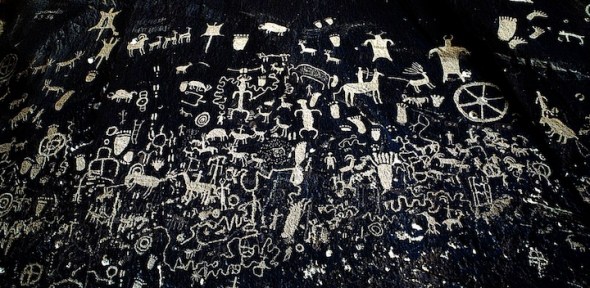
NEWSPAPER ROCK in south central Utah reflects the migratory world view of the ancestors of today’s Pueblo People.
Julian Hayden, judged by many the best field investigator in American Archaeology, worked on both of the legendary Snaketown digs, where he met Pima elders who allowed him to sit in on a three day telling of their (Pima) oral history. Hayden found himself working all day on the dig, listening to the Pima accounting of their past much of the night, then going home and writing it up before work. The Pima Oral History spoke of the first people settling there, but others moved on and over centuries, which became hundreds of years, these first

HAYDEN reported also the Oral History said that a people from the southeast had attacked and destroyed the “great houses” of the Salt-Gila Complex or the Hohokam Canal and Platform Communities. Hayden took that to mean the Sobaipuri Indians of the Upper San Pedro River Valley who once lived in southeastern Arizona.
Sharing some common language its not surprising but to find MesoAmerican influence scattered throughout the American South West and many studies have wondered out loud how much sway the larger civilizations held over the frontier, others have found direct connections between these prehistoric pioneers and Central and South America Civilizations. We find bells forged in Mexico, Macaws from South America, ball courts and Trincheras sites where black volcanic mountains are terraced and take the look of a lush pyramid in a dusty desert.

KOKOPELLI, the watersprinkler brings Spring
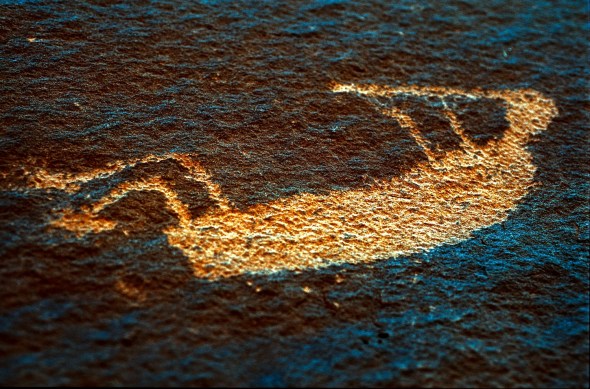
CHINLE WASH, NORTHERN ARIZONA ON THE NAVAJO RESERVATION
In central Arizona where Kokopelli first showed up on pottery in the Hohokam village of Snaketown along today’s Gila River. In Pueblo myths, Kokopelli carries seeds, babies, and blankets to offer the maidens he seduces. According to the Navajo, his hump was made of clouds filled with seeds and rainbows. In the Hopi village of Oraibi, they believe he carried deer skin shirts and moccasins which he used to barter for brides or babies which he left with the young women. Others believe that Kokopelli’s sack contained the seeds of all the plants and flowers in the world, which he scattered each Spring. Legend tell us, everyone in the village would sing and dance throughout the night when they heard Kokopelli play his flute. The next morning, every maiden in the village would be with child.
 Campers still report hearing the haunting, sweet flute sounds floating on the wind along the San Juan River, particularly near Chinle Wash, home to the Navajo’s watersprinkler, the god of fertility and the giver of rain. When Kokopelli played his flute, the sun came out, the snow melted, grass began to grow, birds began to sing, and all the animals gathered around to hear his songs. His flute music soothed the Earth and made it ready to receive his seed.
Campers still report hearing the haunting, sweet flute sounds floating on the wind along the San Juan River, particularly near Chinle Wash, home to the Navajo’s watersprinkler, the god of fertility and the giver of rain. When Kokopelli played his flute, the sun came out, the snow melted, grass began to grow, birds began to sing, and all the animals gathered around to hear his songs. His flute music soothed the Earth and made it ready to receive his seed.
San Ildefonso Pueblo legend, believed Kokopelli’s flute brought happiness, joy and embodied everything pure and spiritual about music. Kokopelli was a wandering minstrel they believe who carried songs on his back, trading new songs for old ones. According to this legend, Kokopelli brought good luck and prosperity to anyone who listened to his music.

A 18×30 inch 300mm lens slice of a rock art panel at Sand Island near Bluff Utah
My most interesting flute-player experience came in the form of a 300mm lens slice of a large rock art panel at Sand Island just south of Bluff Utah. This view showed a flute-playing mountain sheep carved in rock in the midst of the Navajo Nation this rock art is an remnant of the ANASAZI prehistoric culture and this isolated view is only 18 inches by 30 inches sliced from a rock art panel on a 150’ cliff beside the San Juan River. Most of that 150 foot cliff is rock art, this is simply a paragraph.
The detail appeared to me as very unique — a Mountain Goat playing the flute, like Kokopelli, so I pulled this view in with my 300mm lens and thought no more about it until one day when I visited Edgar Perry, a White Mountain Apache Medicine Man and described the panel to him from memory.
Is there a crack between the two groups of sheep? he asked. Yes, I said. “That line represent the real world (topside) and the supernatural world (beneath),” he said. Topside you see two sheep walking on all fours beneath the crack you see two sheep — one standing on two legs and playing a flute and the other on all fours with a bird (raven) appearing from its head the Navajos call this, shape–shifting or perhaps, skinwalkers. The Medicine Man points out the White Sheep becoming a black Raven characterizes the battle between good and bad, right and wrong. Imagine if that much meaning can be taken from a fraction of the panel, imagine what you might learn from the entire display.
Shape-shifting as depicted in this panel is a common supernatural feature attributed to shaman,

Shape-Shifting shaman took on whatever form that was needed.
North American’s rock art began long before the birth of Christ, and continues today. It’s function varies all over the South West. North to New Mexico’s Chaco Canyon, a rock wall there has a series of lines in a single panel said to mark the coming of the summer equinox, a sun dagger is said to mark the coming and going of summer. Elsewhere in Chaco’s back country another panel is said to depict a 10th century Super Nova seen around the world in the prehistoric sky. Is Kokopelli, the flute-player, the first “Kilroy was here” ? Or does this tradition depict another tradition of Mesoamerican traders who plied the prehistoric pathways of yesteryear carrying trade goods, news, entertainment and their own special DNA.

CRACK-IN-THE-ROCK RUIN SUN DAGGER
What we believe is rock art is timeless, it began in Europe 50,000 years ago ! In the American South West, it is believed to be priceless. Last fall a Las Vegas nineteen year old spent nine months in jail and was fined shy of $25,000 for spray painting blue graffiti on top on Rock Art thought to date from 1100 AD. Another incident in the high Sierra, where a team of vandals using ladders, power-saws, hammers, generators–stole four mural scenes by cutting them from 15 feet high lava cliffs, damaging two others.
Incidents like the one in the high Sierra, where an audience is unlikely, sites go unmonitored and with increased human contact brings pressure, cuts to budgets and a lack of enforcement where an implicit risk exists to all the rock art panels scattered though out the South West and deep into Mexico. Many South West archaeologists, like renown rock art researcher, Polly Schaafsma who wonders if south central Utah may well have been the central heart beat of the Rock Art movement.
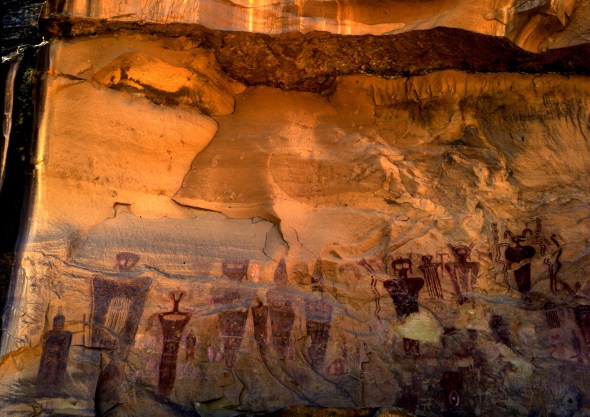
Mid-Utah Fremont Culture drew this panel in Sego Canyon east of the Barrier Canyon Style display in Horseshoe Canyon, which was drawn by the Anasazi ancestors of the Basket-Maker Culture
Despite similarities, Polly Schaafsma suggests interesting differences; the Canyonlands Maze Unit Shaman gallery might be a portrait of all the shamans who over time have led and given direction about life, past spiritual leaders whose combined knowledge would be the fountain of understanding for all things. Unlike, other sites developed over time, this Shaman gallery in the Barrier (Horseshoe) Canyon might have been a single performance — by one artist a snapshot of the ancestors! Some paint is thought to have been blown through a straw.

Perhaps two thousand years have passed since an artist stood flat-footed and painted these drawings
While these shaman wear similar headgear and breastplates seen on the shaman of the Fremont People to the West, the Lower Butler Canyon Rock Art emphasized the animal helpers who worked with the shaman, the ability to hear and see what is hidden, the ability to change shape-a man becomes a mountain sheep or raven — whatever is needed. In Leslie Spier’s book “YUMAN PEOPLE” published around 1925 he interviews lots of Colorado River Tribe members who were 60-70 years old, one tale told of a shaman whose tribe was facing attack and perhaps ambush, who slept on the question and when he arose, he said he had seen the enemy camped on the other side of the mountain leading his warriors to a successful surprise attack.

Enlarged hands may reflect a drug trip where the painter experienced hallucinations about the size of his hands.

Kilroy’ was a 46-year old shipyard worker during the war who worked as a checker at a shipyard . His job was to go around and check on the number of rivets completed. Riveters got paid by the rivet. He would count a block of rivets and put a check mark in waxed lumber chalk, so the rivets wouldn’t be counted twice. Soldiers, Sailors and Marines saw his moniker and began leaving it behind everywhere they went and soon Kilroy had liberated all of Europe before the allies had even arrived.
The Rock Art of the Anasazi Basketmaker Rock Art is still revered, perhaps even feared today, because of its potent power. Many rock art sites have been added to, over time, right up to the present. In the Chinle Wash where Tony Hillerman set the drama found in his book, "A Thief of Time" Polly Schaafsma shows us where someone has attacked a piece of rock art with an axe. The "vandal" completely destroyed the offending design, but Schaafsma suggests this may be a case of self-defense. This area of the Navajo Reservation is said to have skinwalkers who might even work with medicine men.

EARLY MAN CREATED THIS SHAMAN DRAWING BUT NAVAJO MEDICINE MAN USED AN AXE ON THIS DRAWING TO FREE HIS PATIENT

POLLY SCHAAFSMA
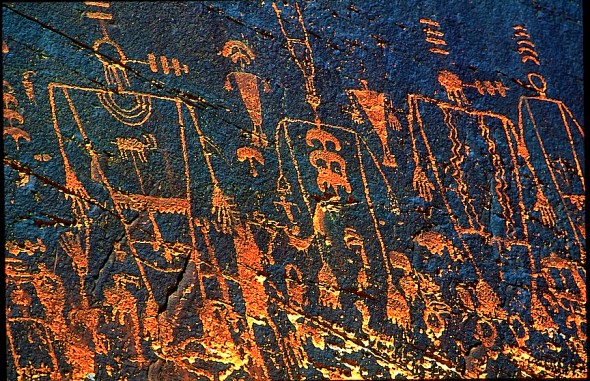
The Lower Butler Wash site shows shaman with their spirit helpers and displaying special abilities to see and hear and perhaps talk through spirit helpers or animal totem to the nature world.
The abstracted anthropomorphs with shamanistic supernatural abilities is a rock art subject repeated again and again in the canyons of the Colorado Plateau, many are surrounded or aided by “animal spirit helpers”, or demonstrate their shape-shifting skills or trance-like abilities that allow the shaman to see lost objects, the presence of evil spirits, the cause of an illness, the future and the past. The Horseshoe Canyon or Barrier Canyon site in the Maze Canyonland district could be the portrait of the principal shaman. When times got bad and resources were scarce they used magic to improve their lot. It would have been very dramatic to bring in new initiates at night with light from torches lighting up the rock art for ritual initiations, drug-assisted vision quests and for praying to your God. The name of your world means “Made for You”.
The Lower Butler Wash was chiseled by an artist pecking a straight controlled line, while the Holy Ghost Gallery was partially sprayed onto the limestone and both reflect this ghostly, ancestrial-spirit overtones which are absent in the Fremont Panels which highlight war-like motifs.

THE HOLY GHOST or EARTH GOD, door keeper to the 5th World of the Hopi and the Keeper of Fire and Master of the Fourth World (our present day world) or MASAUWV or Skeleton Man, the Spirit of Death surrounded by their helpers. This display is believed a one-time ceremony perhaps marking the doorway to the underworld or the Sipapu of all Life! Was it also entrance to both Heaven and Hell ?
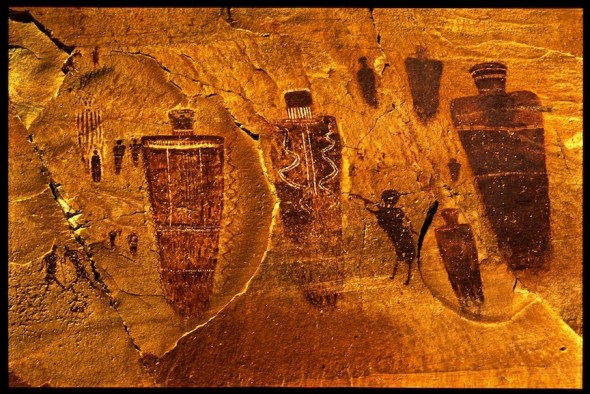
HAND PRINTS APPEAR THROUGHOUT TIME RESEARCHERS BELIEVE IT WAS A WAY FOR SPIRITS TO ID WHOSE PRAYERS. ANTHROMORPHS BEGAN IN THE SAN JUAN AREA AND THE ROCK ART MOTIF SPREAD THROUGH OUT THE ANASAZI WORLD BUT AS TIME EVOLVED ROCK ART BECAME MORE STYLIZED OR DECORATIVE ALL OVER. HORSESHOE CANYON AND BARRIER CANYON ARE ONE AND THE SAME.
“It’s like two different clubs were operating on separate sides of the (San Juan) river,” says Schaafsma about the similarities between the Fremont Culture Shaman Gallery and the one in Horseshoe Canyon judged to be a very old ritual site for the Anasazi Basket Maker Culture. Did the Holy Ghost figure represent the “soul force” of a departed shaman still aiding his flock from the underworld ? Schaafsma believe it was “important to do (paint) it here” beneath this 170′ high rock alcove which may have been viewed as a doorway to the supernatural world. Then there was a “ritualistic painting” which called for a ceremoniously gathering of the materials, sing song in prayer and then the painting in Horseshoe Canyon is believed to be done by one person in a single setting. In rock art an animal drawing upon completion its possible that the artist might attack it with a spear in anticipation of the hunt to come and in hopes of swaying the gods will about the outcome of the hunt.

Fremont Culture Shaman Drawing at Sego Canyon, Utah
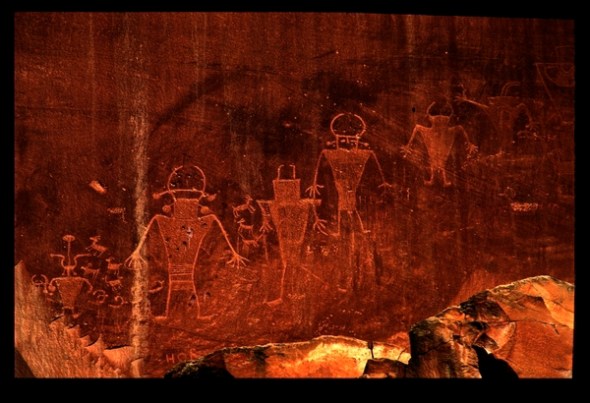
FREMONT CULTURE ROCK ART AT CAPITOL REEF NATIONAL MONUMENT
Newer Rock Art does function much like the graffiti-kids spray on my neighbor’s fence, it shows their territory. Rock Art show many different styles and demonstrates a large number of cultural influences, even where one culture begins, where it begins to morph or blends with other nearby cultures or where an entirely different group begins. Over time researchers find the importance of the message changes, as does, the message. Anasazi Rock Art, like this Hohokam rock art from 1000 AD seems more casual or more graffiti-like than the much older Basket Maker archaic floating Shaman. There is an old Navajo saying that “pride and arrogance” were the downfall of the Anasazi who they believed learned too much and simply disappeared! The Navajo say “They wrote all their knowledge on the rock walls before they left, but over time it became too abstract to understand.

Newspaper Rock outside of Gila Bend AZ at Painted Rocks State Park.
ACID RAIN has been blamed for diminishing the once dramatic rock art gallery of floating Shaman’s found on the covered back wall of an Anasazi Basketmaker II site featuring a fifty foot panel of a dozen figures in Horseshoe Canyon of the Maze District in Utah’s Canyon lands where it is feared the nearby coal-operated Page, AZ electricity generation plant has caused more deterioration in the past 20 years than seen there in the previous 2000 years. South West Rock Art might well have been the original email, a short concise message for a specific audience. Messaging has come full circle, if you buy the email you get today on your smartphone, is the rock art equivalent of a thought expressed on a prominent rock feature certain to capture the desired audience. Graffiti may also link us with those prehistoric artists and archaeologist must struggle with the question, does a nice blank surface require a creative hand to leave its mark–will man make art, regardless of what he has to say “Kilroy was Here!” for instance ? Or is the message everything ?

Prehistoric Rock Art is Disappearing … people and pollution are the main culprits. This famous artwork panel in North Central Baja has been destroyed by vandals drawing on the walls between this old color rock painting so characteristic of all of Bajas’ Rock Art and was once numbered among the best panels to visit.
TEEN GETS PRISON FOR DEFACING 1000 YEAR OLD ROCK ART AND FINED….CLICK HERE
HELP PROTECT THE PAST Rock art must never be touched; oils from human skin can discolor or eventually obliterate the designs. Rock art is protected by the Archaeological resources Protection Act of 1979 and the Antiquities Act of 1906
ROCK ART OF UTAH BY POLLY SCHAAFSMA
VISIT THE SECRET CANYON OF THE FREMONT PEOPLE: VIDEO OF SOME OF THE 6000 PRISTINE PREHISTORIC SITES
HANDBOOK OF ROCK ART RESEARCH BY DAVID S. WHITLEY
SOUTH WEST PHOTO BANK SOUTHWEST ROCK ART PHOTO GALLERIES….CLICK HERE
[caption id="attachment_6968" align="aligncenter" width="489"]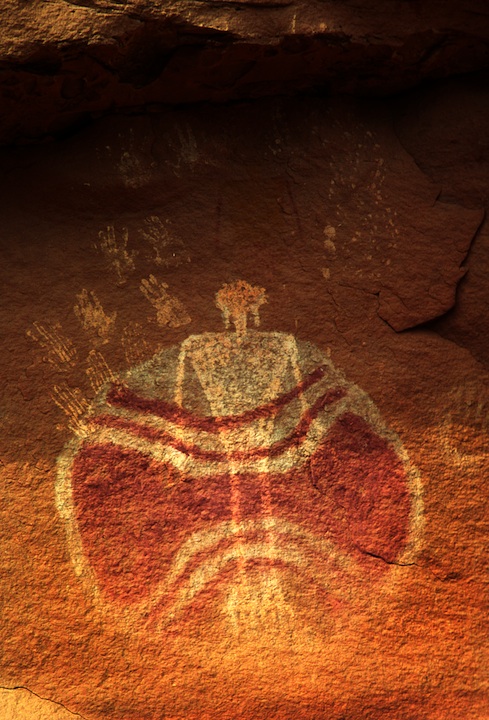 “Baseball Man” perhaps the most intriguing rock art painting in the Chinle Wash System.
“Baseball Man” perhaps the most intriguing rock art painting in the Chinle Wash System.
<a href=" SPANISH TRANSLATIONS:





















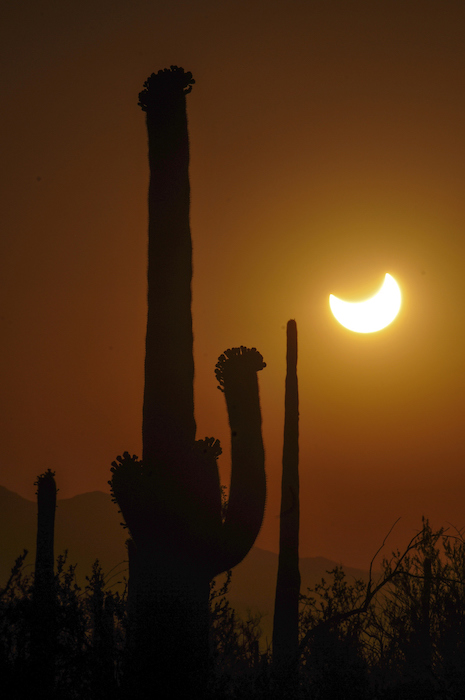





Any way to purchase a copy of some of these pictures?
August 19, 2015 at 12:54 PM
All these photographs live and can be purchased or more associated views can be seen at SouthWestPhotoBank.Com
September 14, 2020 at 2:23 PM